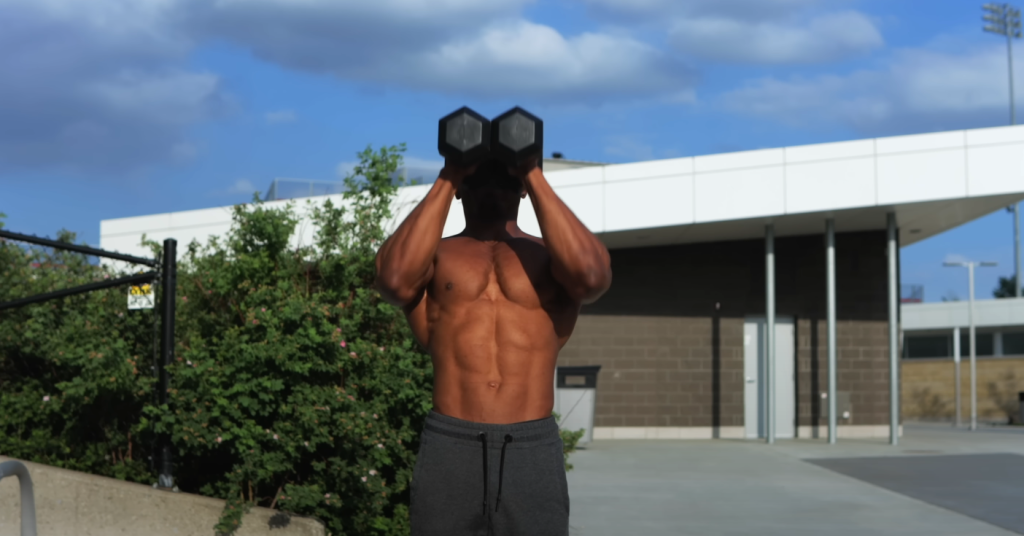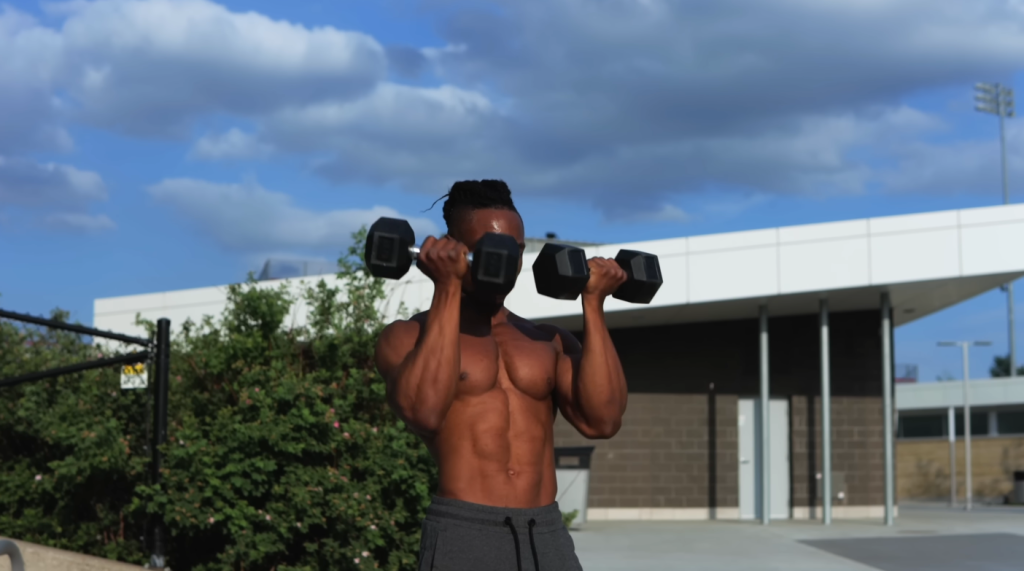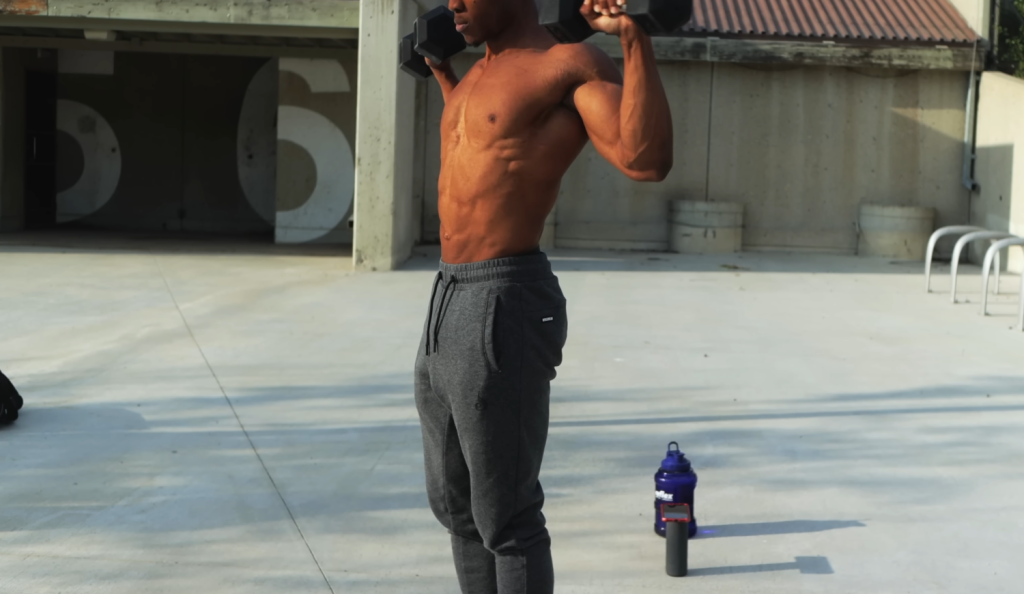Dumbbells are versatile and effective tools for building and sculpting the trapezius muscles, often referred to simply as ‘traps’. These muscles, which span the neck, shoulders, and upper back, can greatly enhance the appearance and strength of your upper body when properly conditioned. In this article, we will explore various trap exercises that can be performed using dumbbells, demonstrating how they can be integrated into your regular workout routine to yield optimal results.
What Are Dumbbells?
Dumbbells are a type of strength training equipment that are widely used in fitness routines. They consist of a short bar with weights on either end, which can range from 1 pound to over 100 pounds each. Dumbbells allow for a wide range of exercises and movements, making them versatile and effective for building muscle and strength.

Benefits of Using Dumbbells
There are numerous benefits to incorporating dumbbells into your fitness routine. Here are just a few:
- Improved Muscular Strength:Using dumbbells for resistance training can help increase muscle strength and size, making everyday tasks easier and reducing the risk of injury.
- Increased Joint Stability:Dumbbell exercises often require you to use stabilizing muscles, which can improve joint stability and reduce the risk of injury.
- Versatility:As mentioned earlier, dumbbells allow for a wide range of exercises that target different muscle groups. This makes them a great option for full-body workouts or targeting specific areas.
- Convenience:Dumbbells are relatively small and compact compared to other strength training equipment, making them easy to store and use at home or in a gym setting.
- Balance and Coordination:Dumbbell exercises can help improve balance and coordination, as you are required to stabilize your body while performing the movements. [1]
Trap Exercises With Dumbbells
The trapezius muscles, commonly referred to as “traps,” are located on either side of your neck and extend down to your upper back. These muscles play a crucial role in shoulder movement and stability. Here are some effective dumbbell exercises that target the traps:
- Dumbbell Shrugs:Stand with your feet shoulder-width apart, holding a dumbbell in each hand by your sides. Lift your shoulders up towards your ears, then slowly lower them back down. Repeat for multiple reps.
- Dumbbell Upright Rows:Stand with your feet shoulder-width apart, holding a dumbbell in each hand in front of your thighs. Keeping your elbows close to your body, lift the dumbbells up towards your chin, then slowly lower them back down. Repeat for multiple reps.
- Dumbbell Farmer’s Carry:Hold a dumbbell in each hand, by your sides. Walk forward while keeping your shoulders down and back, engaging your traps to stabilize the weight. This exercise can also be done with one arm at a time.
- Dumbbell Face Pulls:Attach resistance bands to an anchor point at shoulder height. Hold a dumbbell in each hand and stand facing the anchor point. Pull the bands towards your face while keeping your elbows high and squeezing your shoulder blades together. Slowly release and repeat for multiple reps.

How to Perform Trap Exercises With Dumbbells Safely
As with any exercise, it’s essential to maintain proper form and technique when performing trap exercises with dumbbells. Here are some tips to ensure you are doing these exercises safely:
- Start with light weights and gradually increase as your strength improves.
- Engage your core muscles for stability during the movements.
- Keep your neck and back in a neutral position, avoiding any excessive bending or twisting.
- Avoid shrugging your shoulders up too high, as this can put unnecessary strain on your neck and traps.
- If you experience any pain or discomfort, stop the exercise and consult a fitness professional for proper form guidance.
Incorporating dumbbell trap exercises into your fitness routine can help build strong and stable trapezius muscles, improving your overall strength and function. Remember to always listen to your body and exercise safely for the best results. So go ahead and grab those dumbbells for a challenging and effective workout! [2]

Common Mistakes to Avoid When Doing Trap Exercises With Dumbbells
While dumbbell trap exercises can be highly effective, there are some common mistakes that people often make when performing them. Here are a few to avoid:
- Using too much weight: It’s essential to start with lighter weights and gradually increase as you build strength. Using too much weight can lead to improper form and potential injury.
- Neglecting proper form:As mentioned earlier, maintaining proper form is crucial for safety and effectiveness. Avoid swinging the weights or using momentum to lift them.
- Not targeting all areas:The traps are a complex muscle group, so it’s important to target all areas with a variety of exercises rather than just one or two.
By being aware of these common mistakes, you can ensure you are getting the most out of your dumbbell trap exercises and avoiding any potential injuries.
Tips for Effective Trap Workouts With Dumbbells
Here are some additional tips to help you get the most out of your dumbbell trap workouts:
- Incorporate a mix of heavy and light weights for optimal muscle growth.
- Vary your exercises and include different angles to target all areas of the traps.
- Don’t neglect other supporting muscles, such as the shoulders and upper back, as they also play a role in trap exercises.
- Allow for proper rest and recovery between workouts to prevent overtraining.
By following these tips, you can create an effective and well-rounded dumbbell trap workout that will help you reach your fitness goals. Remember to always listen to your body and adjust as needed for the best results. [3]

Top 12 of Common Trap Exercises With Dumbbells and How to Do Them
While many people may associate trap exercises with barbells or machines, using dumbbells can also be an effective way to build and strengthen your traps. In this article, we will take a look at the top 12 trap exercises with dumbbells and how to properly perform them.
1) Dumbbell Shrugs
One of the most basic and popular trap exercises is the dumbbell shrug. Stand tall with your feet shoulder-width apart and hold a dumbbell in each hand. Keeping your arms straight, shrug your shoulders up as high as you can before slowly lowering them back down.
2) Dumbbell Upright Rows
Similar to the barbell upright row, this exercise targets both your traps and deltoids. Begin by holding a dumbbell in each hand with an overhand grip. Lift the dumbbells towards your chin, keeping them close to your body and your elbows pointing outwards. Slowly lower the weights back down.
3) Dumbbell High Pulls
Stand with your feet shoulder-width apart and hold a dumbbell in each hand, palms facing backwards. Lift the dumbbells up to chest level while bending at the elbows. Keep your back straight and squeeze your traps at the top of the movement before slowly lowering the weights.
4) Dumbbell Power Cleans
Similar to high pulls, power cleans also target your traps and involve explosive movements. Begin by holding the dumbbells in front of you, palms facing backwards. As you jump, bring the dumbbells up to your shoulders, bending your elbows and rotating your wrists. Lower the weights back down to complete one rep.

5) Dumbbell Farmer’s Walk
This exercise not only works your traps but also engages your core and improves grip strength. Hold a dumbbell in each hand at your sides and walk for a specified distance or time while keeping your back straight and shoulders pulled back. [4]
6) Dumbbell YTWL
This exercise targets all three parts of the traps – upper, middle, and lower. Stand with your feet shoulder-width apart and hold a dumbbell in each hand at your sides. Keeping your back straight, lift the weights up to form a “Y” shape with your arms overhead. Lower them down to form a “T” shape, then an “W” shape, and finally an “L” shape before bringing them back down to your sides.
7) Dumbbell Reverse Flyes
Another exercise that targets all three parts of the traps is the dumbbell reverse fly. Begin by bending at the waist with a slight bend in your knees and hold a dumbbell in each hand. Lift the weights up and out to your sides while squeezing your shoulder blades together, then slowly lower them back down.
8) Dumbbell Lateral Raises
While this exercise is primarily known for targeting the shoulders, it also engages your traps. Stand with your feet shoulder-width apart and hold a dumbbell in each hand at your sides. Keeping your arms straight, lift the weights up and out to your sides until they reach shoulder level. Slowly lower them back down.
9) Dumbbell Front Raises
Similar to lateral raises, front raises also engage your traps in addition to targeting your shoulders. Stand with your feet shoulder-width apart and hold a dumbbell in each hand at your sides. Lift the weights up and out in front of you until they reach shoulder level, then slowly lower them back down. [5]
10) Dumbbell Bent-Over Rows
This compound exercise targets multiple muscle groups, including your traps. Stand with your feet shoulder-width apart and hold a dumbbell in each hand at your sides. Bend at the waist while keeping your back straight and lift the weights up and towards your chest, squeezing your shoulder blades together. Slowly lower them back down.
11) Dumbbell Shrugs with Resistance Bands
To add an extra challenge to your dumbbell shrugs, try incorporating resistance bands into the exercise. Begin by standing on a resistance band with both feet and holding a dumbbell in each hand. As you shrug your shoulders up, also pull the bands up towards your ears. Slowly lower both the weights and bands back down.

12) Dumbbell Single-Arm Overhead Press
While this exercise primarily targets your shoulders, it can also engage your traps as a secondary muscle group. Begin by holding a dumbbell in one hand at shoulder level with an overhand grip. Press the weight up overhead until your arm is fully extended, then slowly lower it back down. Repeat with the other arm.
Incorporating these top 12 trap exercises with dumbbells into your workout routine can help you build and strengthen your traps for a well-rounded upper body strength and physique. Remember to always use proper form and start with lighter weights before increasing the weight for a challenging workout. So don’t be afraid to grab those dumbbells and get ready to feel the burn in your traps!
How to Incorporate Trap Exercises with Dumbbells into Your Workout Routine
To optimize your trap workout with dumbbells, here are a few tips to keep in mind:
- Warm up properly:Before jumping into any exercise, it’s important to warm up your muscles to prevent injury and prepare them for the upcoming movements. A quick five-minute warm-up can include light cardio or dynamic stretches.
- Start with lighter weights:As with any new exercise, start with lighter weights to ensure proper form and technique. As you become comfortable with the movements, gradually increase the weight for a more challenging workout.
- Incorporate variety:Don’t stick to just one or two trap exercises with dumbbells. Mix it up by incorporating different exercises into your routine to target all three parts of the traps.
- Don’t neglect other muscle groups:While it’s important to focus on your traps, don’t forget to incorporate other muscle groups into your workouts for a well-rounded routine.
- Listen to your body:Always listen to your body and adjust accordingly. If you feel any pain or discomfort, stop the exercise and reassess your form. It’s better to take a break and prevent injury than to push through and potentially cause harm.
- Stay consistent:Like any exercise, consistency is key. Aim to incorporate trap exercises with dumbbells into your routine at least twice a week for optimal results.
By following these tips, you can effectively incorporate trap exercises with dumbbells into your workout routine and see improvements in your upper body strength and physique. [6]

FAQs
What are some effective dumbbell exercises for traps?
There are a variety of effective dumbbell exercises that can help strengthen and develop your traps. Some popular ones include:
- Dumbbell shrugs: Stand with your feet shoulder-width apart and hold a pair of dumbbells at your sides. Slowly lift your shoulders up towards your ears, squeezing the traps at the top, then lower back down.
- Dumbbell upright rows: Stand with your feet shoulder-width apart and hold a pair of dumbbells in front of your thighs. Lift the weights up towards your chin, keeping them close to your body, then lower back down.
- Dumbbell lateral raises: Stand with your feet shoulder-width apart and hold a pair of dumbbells at your sides. Keeping your arms straight, lift the weights out to your sides until they reach shoulder height, then lower back down.
- Dumbbell high pulls: Stand with your feet shoulder-width apart and hold a pair of dumbbells in front of your thighs. Pull the weights up towards your shoulders, bringing your elbows up and out to the sides, then lower back down.
How often should I do dumbbell trap exercises?
The frequency of your dumbbell trap exercises will depend on your fitness level and goals. For beginners, it is recommended to start with 2-3 workouts per week, allowing for a day of rest in between. As you become more advanced, you can increase the frequency to 4-5 workouts per week. It is important to listen to your body and not overdo it, as proper rest and recovery are essential for muscle growth and development.
Can I use dumbbells of any weight for trap exercises?
It is generally recommended to start with lighter weights and gradually increase the weight as you become stronger and more comfortable with the exercises. Using too heavy of a weight can lead to improper form and potential injury. It is always best to consult with a fitness professional for personalized recommendations on weight selection.
Should I incorporate dumbbell trap exercises into my full body workouts or do them separately?
It is ultimately up to personal preference and what works best for your body. Some people prefer to incorporate trap exercises into their full body workouts, while others prefer to target them specifically in a separate workout. Both can be effective, so it is important to experiment and see what feels best for you. Keep in mind that proper form and adequate rest are key for achieving optimal results.
What are the benefits of using dumbbells for trap exercises?
Dumbbells offer a number of benefits for trap exercises, including:
- Improved stability and balance: Dumbbells require more stabilization than machines or barbells, helping to engage the smaller stabilizing muscles in your traps.
- Better range of motion: With dumbbells, you have a greater range of motion compared to other equipment, allowing for better muscle activation and development.
- Functional training: Dumbbell exercises mimic natural movements, making them great for functional training and everyday activities.
- Versatility: Dumbbells can be used in a variety of ways to target your traps from different angles, helping to prevent plateaus and keep your workouts challenging.
Are dumbbell trap exercises suitable for all fitness levels?
Dumbbell trap exercises can be modified and adapted to suit a wide range of fitness levels. It is important to start with lighter weights and proper form, gradually increasing the weight as you become stronger. If you have any pre-existing injuries or conditions, it is recommended to consult with a healthcare professional before beginning any new exercise routine. With proper technique and progressions, dumbbell trap exercises can be beneficial for all fitness levels. Keep in mind to listen to your body and adjust as needed.
How long does it take to see results from dumbbell trap exercises?
The time frame for seeing results from dumbbell trap exercises will vary based on factors such as frequency, intensity, nutrition, and individual genetics. Consistency is key, and with a balanced exercise routine and proper nutrition, you can expect to start seeing improvements within a few weeks. Remember that results take time, so be patient and stay committed to your fitness journey. Every small improvement is progress towards achieving your goals!
What are some other tips for incorporating dumbbell trap exercises into my workouts?
- Warm up properly: Before starting your dumbbell trap exercises, it is important to warm up your muscles and prepare them for the workout. This can help prevent injury and improve performance.
- Focus on proper form: It is crucial to maintain proper form during dumbbell trap exercises to target the right muscles and avoid strain or injury. If you are unsure of proper form, seek guidance from a certified fitness professional.
- Gradually increase weight: As you become stronger and more comfortable with the exercises, gradually increase the weight to continue challenging your muscles and promoting growth.
- Incorporate rest days: Allow for proper rest and recovery in between dumbbell trap workouts to prevent overtraining and promote muscle repair and growth. And remember, getting adequate sleep is also important for muscle recovery!
Can I use dumbbells to train traps at home?
Yes, dumbbells can be a great tool for training your traps at home. You can perform a variety of exercises using just dumbbells to target your traps from different angles and challenge your muscles. Make sure you have enough space and use proper form to avoid injury. Some recommended exercises for training traps at home with dumbbells include:
- Dumbbell shrugs
- Dumbbell upright rows
- Dumbbell high pulls
- Dumbbell lateral raises
Ultimately, incorporating dumbbell trap exercises into your fitness routine can help improve strength, stability, and muscle development in your shoulders and upper back. Remember to listen to your body, maintain proper form, and gradually progress for optimal results. Consult with a certified fitness professional for personalized recommendations and guidance.
What weight of dumbbells should I use for trap exercises?
The weight of dumbbells you should use for trap exercises will vary based on your fitness level and goals. As a general recommendation, beginners should start with lighter weights (around 5-10 pounds) and gradually increase as they become stronger. More advanced individuals may need heavier weights (15+ pounds) to continue challenging their muscles. Again, it is always best to consult with a fitness professional for personalized recommendations. Experiment and find what weight works best for you, always keeping proper form in mind.
Are there any safety precautions I should take when doing trap exercises with dumbbells?
Yes, it is important to take proper safety precautions when doing any exercise, especially with equipment like dumbbells. Some tips for staying safe during trap exercises with dumbbells include:
- Using a weight that you can comfortably control and maintain proper form with.
- Keeping your movements controlled and avoiding swinging or jerking motions.
- Avoiding locking out your joints at the top of the exercise.
- Not lifting beyond your current ability or fitness level.
- Using a spotter if necessary for heavier weights.
Remember to always prioritize safety and listen to your body. If an exercise feels too challenging or causes any pain, stop immediately and consult with a professional.
Can trap exercises with dumbbells help improve posture?
Yes, incorporating trap exercises with dumbbells into your workouts can help improve posture by strengthening the muscles in your upper back and shoulders. These muscles play a critical role in maintaining good posture and preventing common issues such as rounded shoulders or a hunched back. Along with proper form during exercises, it is important to also focus on maintaining good posture throughout your daily activities for optimal results.
Conclusion
In conclusion, dumbbells are a versatile and effective tool for targeting your traps and promoting overall upper body strength. With proper form, gradual progression, and consistency, you can see results from dumbbell trap exercises in just a few weeks. Remember to always prioritize safety and listen to your body when incorporating any new exercise into your routine. Consult with a professional for personalized recommendations and guidance. Stay dedicated, stay consistent, and celebrate every small improvement on your fitness journey! Keep working hard and you’ll see the results you desire. Now go grab those dumbbells and get ready to train those traps! Happy lifting!
Useful Video: 15 MINUTE LIGHTWEIGHT DUMBBELL SHOULDERS & TRAPS WORKOUT!
References:
- https://www.bodybuildingmealplan.com/dumbbell-trap-exercises/
- https://fitnessvolt.com/dumbbell-trap-exercises/
- https://www.sportskeeda.com/health-and-fitness/7-best-dumbbell-exercises-men-build-bigger-traps
- https://fitliferegime.com/best-dumbbell-trap-exercises-for-mass-and-strength/
- https://thefitnessphantom.com/best-dumbbell-trapezius-exercises
- https://anabolicaliens.com/blogs/the-signal/intense-5-minute-dumbbell-trap-workout-get-bigger-traps-today

